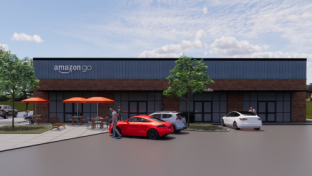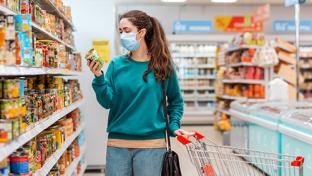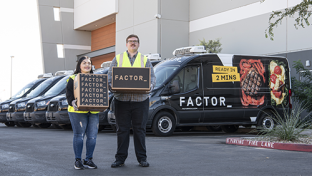How Amazon Plans to Transform Grocery in 2022
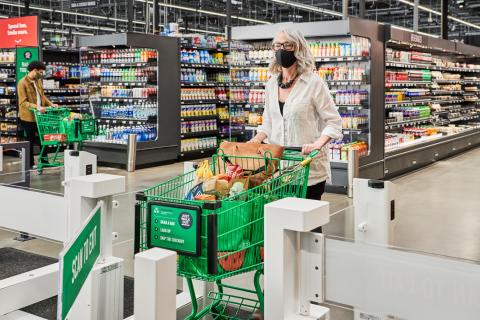
It’s been 18 months since Amazon opened its first full-size supermarket, and a question on the mind of everyone in the retail industry is: What’s next for the e-commerce giant’s grocery aspirations?
The chief of the company’s Amazon Fresh grocery banner answers that question in an exclusive interview with Progressive Grocer.
“Amazon’s cultural bedrock is customer obsession, which drives all of our various businesses to innovate for customers in big and small ways, and to agonize over the things that matter most to them,” says Jeff Helbling, VP of Amazon Fresh. “As we open more Amazon Fresh stores, we will continue to invest in technology — like our Just Walk Out shopping and the Amazon Dash Cart — to make the grocery shopping experience more convenient for customers.”
Leveraging the lessons from its $13 billion acquisition of Whole Foods Market in 2017, and continuing to focus on ruthless execution and experimentation, Amazon is on the cusp of transforming grocery with what is expected to be an acceleration of openings for its Amazon Fresh format this year.
Since the company launched its first foray into traditional grocery in Woodland Hills, Calif., in August 2020, Amazon has opened 23 Amazon Fresh stores across six states and the District of Columbia. At this very moment, there are at least two dozen Amazon Fresh stores in various stages of planning or construction across the United States, and Amazon reportedly has plans to open dozens if not more of these stores in major U.S. metros in the next three years. The Amazon Fresh stores, which range in size from 25,000 to 45,000 square feet, join the company’s other U.S. physical locations selling food and consumables: 511 Whole Foods Market stores and 24 Amazon Go stores.
“We give ourselves the ability to innovate, test and learn, and adapt to meet the changing needs of our customers,” Helbling says. “That’s why, for example, as our grocery offering has grown, we moved Prime Now to the Amazon app and website so customers can shop all Amazon has to offer from one convenient location, and we opened Amazon Fresh grocery stores to give customers a convenient shopping experience thanks to Just Walk Out technology and the Amazon Dash Cart.”
Just Walk Out technology (cashierless checkout) and the Dash Cart (shopping carts with checkout functionality) join other grocery experiments currently scaling up, such as Amazon Key In-Garage (grocery delivery straight to customer garages), Amazon One (palm-payment technology), and private brands.
According to Helbling, the Amazon Fresh experiment has been a big success so far.
“Our efforts to evolve our grocery experience into a seamless omnichannel offering have been well received by customers — and the industry,” he says.
Retail analytics firm Placer.ai recently examined the performance of Amazon’s first Amazon Fresh grocery stores in California and Illinois, and found that those stores are gaining market share against traditional grocery operators.
“The relative steadiness in visits shows that a core group of customers have added a trip to Amazon Fresh to their regular grocery routine, indicating that Amazon Fresh has successfully integrated into the grocery mix for the neighborhoods it entered,” observes Shira Petrack, a Placer.ai blogger.
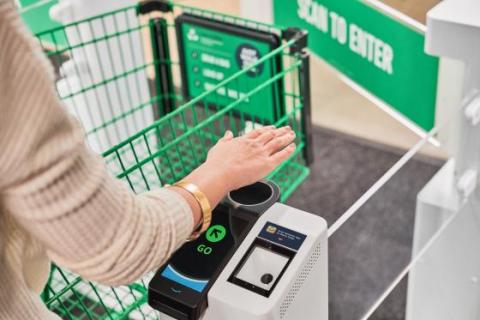
A Top 10 Grocer — Twice
Last month, in a second year dominated by the COVID-19 pandemic, Amazon cemented its leadership position in dunnhumby’s Retailer Preference Index (RPI) for U.S. grocery by landing the No. 1 and the No. 5 spots in the ranking. Amazon took first place, and Amazon Fresh took fifth place (the first time a food retailer has nabbed two spots in the top 10).
“The pandemic has massively accelerated changes in how customers buy their groceries, and their behaviors are continuing to evolve,” says Grant Steadman, president of North America for dunnhumby. “2021 was the year that grocery retail became truly omnichannel. Retailers who delivered on their customers’ evolving needs in-store and online performed best. This was mostly the larger players, who used their advantages to consolidate their positions. The challenges for most other retailers are significant, but a number of midsize grocers gained momentum by understanding their customers better and differentiating their offering accordingly. The report aims to provide some direction on why and how retailers can best position themselves to win with customers, in this era of the Great Reinvention.”
The overall RPI rankings are the result of a statistical model that predicts how retailer execution on various customer needs — preference drivers — affects lasting emotional bonds formed with customers, as well as near- and long-term financial performance. The study includes key findings such as:
- Price and quality are no longer head and shoulders above all other customer preference drivers in securing superior, long-term sales growth and emotional connection with shoppers.
- Retailers in the first quartile have long-term sales growth that’s nine times higher than retailers in the fourth quartile, two times higher than retailers in the third quartile, and one and a half times higher than retailers in the second quartile. They also have superior short-term momentum to those in the other three quartiles.
- Grocery retail is now truly omnichannel, as digital’s share of total grocery sales more than doubled during the pandemic, from 5% to 10% of sales, yet half of the U.S. grocery shopping population doesn’t buy online and has no plans to. Nearly all online shoppers still buy in brick and mortar, where roughly 90% of all customer dollars are currently spent.
- Digital is king in driving momentum as Amazon has demonstrated over the past two years by being ranked as the top U.S. grocery retailer.
With a strong balance sheet, a burgeoning software-as-a-service business and a strengthened physical stores team in place, Amazon’s grocery ambitions are ready for liftoff.

‘New Capabilities in Grocery’
When Amazon reported fourth quarter earnings on Feb. 3, the company was still growing sales by double digits from the pandemic-elevated levels of 2020. Amazon said net sales increased 9% to $137.4 billion. Net income increased to $14.3 billion, a near-doubling of profits. Amazon also reported that its physical store sales (including food retail banners Whole Foods Market, Amazon Fresh, and Amazon Go) were up 16% during the quarter. It was the third straight quarter of double-digit growth for the company's physical stores.
Amazon CEO Andy Jassy said the company is seeing "higher costs driven by labor supply shortages and inflationary pressures" and that these issues are persisting into the first quarter due to Omicron. But, he said, despite these short-term challenges, "we continue to feel optimistic and excited about the business as we emerge from the pandemic." Jassy specifically referenced excitement over "new capabilities" the company is building in grocery.
Amazon is still following the same “short-term pain in exchange for long-term gain” growth strategy it has championed since the company first went public in 1997, one that occasionally disappoints investors but strikes fear into the hearts of competitors.
The company’s forecast for fourth-quarter revenue calls for year-over-year growth between 4% and 12%. The guidance for operating income is between $0 and $3 billion. Of course, part of the reason for decreases in profitability is that costs are exacerbated by the current labor environment.
“Across Amazon, we have hired more than 600,000 people globally during the pandemic,” Helbling says. “For Amazon Fresh, every time we open a store, we’re creating hundreds of new job opportunities to help us deliver a shopping experience that customers will love, right in their own communities. These are great jobs with industry-leading pay and benefits.”
By the end of 2021, Amazon Fresh stores had created more than 6,000 jobs, according to the company.
“Our Amazon Fresh store team is strong and growing,” affirms Stephenie Landry, VP of Amazon Grocery. “I’ve enjoyed getting to know employees and seeing first-hand how they support each other and our customers, while visiting our stores. Because of this amazing team, we’re able to bring customers a new, innovative shopping experience.”
At the end of the third quarter, Amazon had 1.5 million employees and its starting hourly wages were at least $15 per hour for all full-time, part-time and seasonal employees and contractors. In addition, employees now have opportunities to own Amazon stock, participate in 401(k) plans with a 50% company match, and enroll in paid life and accident insurance. Last year, Amazon began offering signing bonuses of up to $3,000 as it aimed to hire 125,000 delivery and warehouse workers across the United States. The company also raised its average starting wage to $18 an hour.
“All of our full- and part-time positions offer employees highly competitive wages, along with a variety of benefits packages starting on the employee’s first day on the job,” Helbling notes. “We also provide employees the opportunity to learn new skills and grow with us at Amazon, as well as access to our innovative Career Choice program, which provides education and training for in-demand jobs.”
The other short-term hit on Amazon’s profits has been supply chain-related. Helbling admits that the company hasn’t been “immune to the supply chain challenges everyone is facing currently.
“To address it, we are continuing to add staff, creating work opportunities for people who want them, innovating across our supply chain, and working to get inventory closer to customers so we can provide products and improve delivery speeds,” he adds.
As for how the retailer is replenishing its Amazon Fresh stores, Helbling says that it’s using local and national suppliers, and leveraging the Whole Foods Market supply chain already in place.
“We use a variety of suppliers, including both national suppliers and local suppliers, and we do share some suppliers with Whole Foods Market,” he explains. “For example, we source many of our meat products, fresh seafood and produce from some of the same suppliers and farms that supply Whole Foods Market.”
In October 2020, Grand Rapids, Mich.-based SpartanNash, which has been working with Amazon since 2016 and supplies Amazon Fresh stores, filed paperwork to sell as much as 15% of its stock to Amazon by 2027. If Amazon is looking to build an integrated grocery distribution vertical, a minority stake in SpartanNash will provide all of the learnings it needs to do that.

Just Walk Out
It seems longer ago, but it’s only been four years since Amazon debuted technology at an 1,800-square-foot Amazon Go store in Seattle that allowed shoppers to exit a store without stopping at a checkout. Amazon’s Just Walk Out (JWO) technology offers shoppers the ability to enter, shop for the items they want and simply exit the store. Shoppers using Just Walk Out also have the option to use Amazon One, a contactless way for people to enter, identify and pay using their palm. After customers leave the store, those who use the Just Walk Out experience receive a digital receipt.
In September, the company revealed that it would be rolling out JWO to full-size supermarkets: select Whole Foods Market and Amazon Fresh stores. Amazon scaling contactless payment options and its JWO innovation in 2022 couldn’t be more ideally timed. The pandemic has prompted consumers to favor the perceived safety and convenience of innovations such as JWO. According to Amazon, it’s hearing from shoppers across its grocery ecosystem that they want to skip the hassle, stress and pandemic-unfriendly crowding associated with checkout lanes.
“We’ve heard from customers how much they appreciate the checkout-free shopping experience that Just Walk Out technology offers at both Amazon’s stores and other retailers’ stores,” says Dilip Kumar, VP, physical retail and technology at Amazon.
For Amazon, the artificial intelligence-driven technology could dramatically reduce labor spend and improve inventory management and overall in-store operations. In addition, it makes sense for the company to want to showcase the capabilities of JWO technology in as many stores as possible as other retailers mull whether to buy the tech. According to Bloomberg, Amazon Go collaborated with Starbucks to open a new store concept involving Just Walk Out technology, and Amazon works with third-party customers such as British grocery chain Sainsbury’s and airport c-store operator Hudson Group to enable select stores with Just Walk Out technology. Amazon One is now available at more than 70 Amazon physical retail stores and Whole Foods Market stores, along with third-party locations.
As for Amazon Fresh, JWO is poised to roll out in more of those stores as well.
“To date, we’ve opened 23 Amazon Fresh stores in the U.S. that enable customers to skip the checkout line thanks to our Just Walk Out technology or the Amazon Dash Cart,” Helbling says. “We look forward to bringing this convenient grocery shopping experience to even more customers in California, Illinois, New Jersey, Pennsylvania, Virginia and Washington state, where we’ve confirmed more Amazon Fresh stores will open.”
Last month, Amazon showed how serious it is about scaling its grocery business when it welcomed Tony Hoggett to its headquarters in Seattle. Hoggett had been with Tesco, the United Kingdom’s biggest food retailer, for more than 31 years and was chief strategy and innovation director. Hoggett has joined Amazon as SVP of physical stores, reporting to Dave Clark, chief executive of its worldwide consumer business.
In a Jan. 7 LinkedIn post, Hoggett wrote: “Well, today is officially my last day at Tesco. It’s time for me to say farewell to a truly amazing set of work colleagues. … I wish you all the very best of luck for the future. Hello to the Amazon team, very excited to be working with you all.”
Hoggett had a reputation at Tesco for running exceptional multiformat retail operations, a perfect fit for Amazon’s grocery ambitions. He will need to partner with Helbling and Landry as the company looks to scale its grocery business over the next three to five years.
Helbling says that he’s focused on applying learnings as the company continues to open more grocery stores.
“All customers want a neighborhood grocery store that offers a broad selection of high-quality foods available at low prices, and a convenient shopping experience,” he continues. “Our Amazon Fresh stores deliver on that. But we also recognize that each community where we open a store is unique and has different needs. We focus on listening to customer feedback and adjust selection based on what we’re hearing to meet the needs of customers shopping that store. For example, at our Amazon Fresh store in Seattle, we kept hearing from customers that they wanted collard greens in our prepared foods hot bar, so we added them to our menu.”
California
Amazon Fresh Store — Fullerton
1100 S Harbor Blvd
Fullerton, CA 92832
Amazon Fresh Store — Irvine
13672 Jamboree Rd
Irvine, CA 92602
Amazon Fresh Store — Long Beach
6235 E Spring St
Long Beach, CA 90808
Amazon Fresh Store — Ladera Heights
6855 S La Cienega Blvd
Los Angeles, CA 90045
Amazon Fresh Store — North Hollywood
5101 Lankershim Blvd
North Hollywood, CA 91601
Amazon Fresh Store — Northridge
19340 Rinaldi St
Northridge, CA 91326
Amazon Fresh Store — Whittier
15225 Whittier Blvd
Whittier, CA 90603
Amazon Fresh Store — Woodland Hills
6245 Topanga Canyon Blvd
Woodland Hills, CA 91367
Amazon Fresh Store — Cerritos
11340 South St
Cerritos, CA 90703
Amazon Fresh Store — La Habra
1610 W Imperial Hwy
La Habra, CA 90631
Illinois
Amazon Fresh Store — Bloomingdale
404 Army Trail Rd
Bloomingdale, IL 60108
Amazon Fresh Store — Naperville
3116 S Rt 59
Naperville, IL 60564
Amazon Fresh Store — Oak Lawn
4031 W 95th St
Oak Lawn, IL 60453
Amazon Fresh Store — Schaumburg
16 A East Golf Road
Schaumburg, IL 60173
Amazon Fresh Store — Westmont
30 W 63rd St
Westmont, IL 60559
Amazon Fresh Store — Morton Grove
6931 Dempster St
Morton Grove, IL 60053
Maryland
Amazon Fresh Store – Chevy Chase
5463 Wisconsin Ave
Chevy Chase, MD 20815
Pennsylvania
Amazon Fresh Store – Warrington
389 Easton Rd
Warrington, PA 18976
Virginia
Amazon Fresh Store — Franconia
7005 Manchester Blvd
Franconia, VA 22310
Washington State
Amazon Fresh Store — Factoria
3901 Factoria Square Mall SE
Bellevue, WA 98006
Amazon Fresh Store — Seattle
2301 S Jackson St
Seattle, WA 98144
Amazon Fresh Store — AVA Capitol Hill
610 E Pike St
Seattle, WA 98122
Washington, DC
Amazon Fresh Store – Logan Circle
1733 14th St NW
Washington, DC 20009


